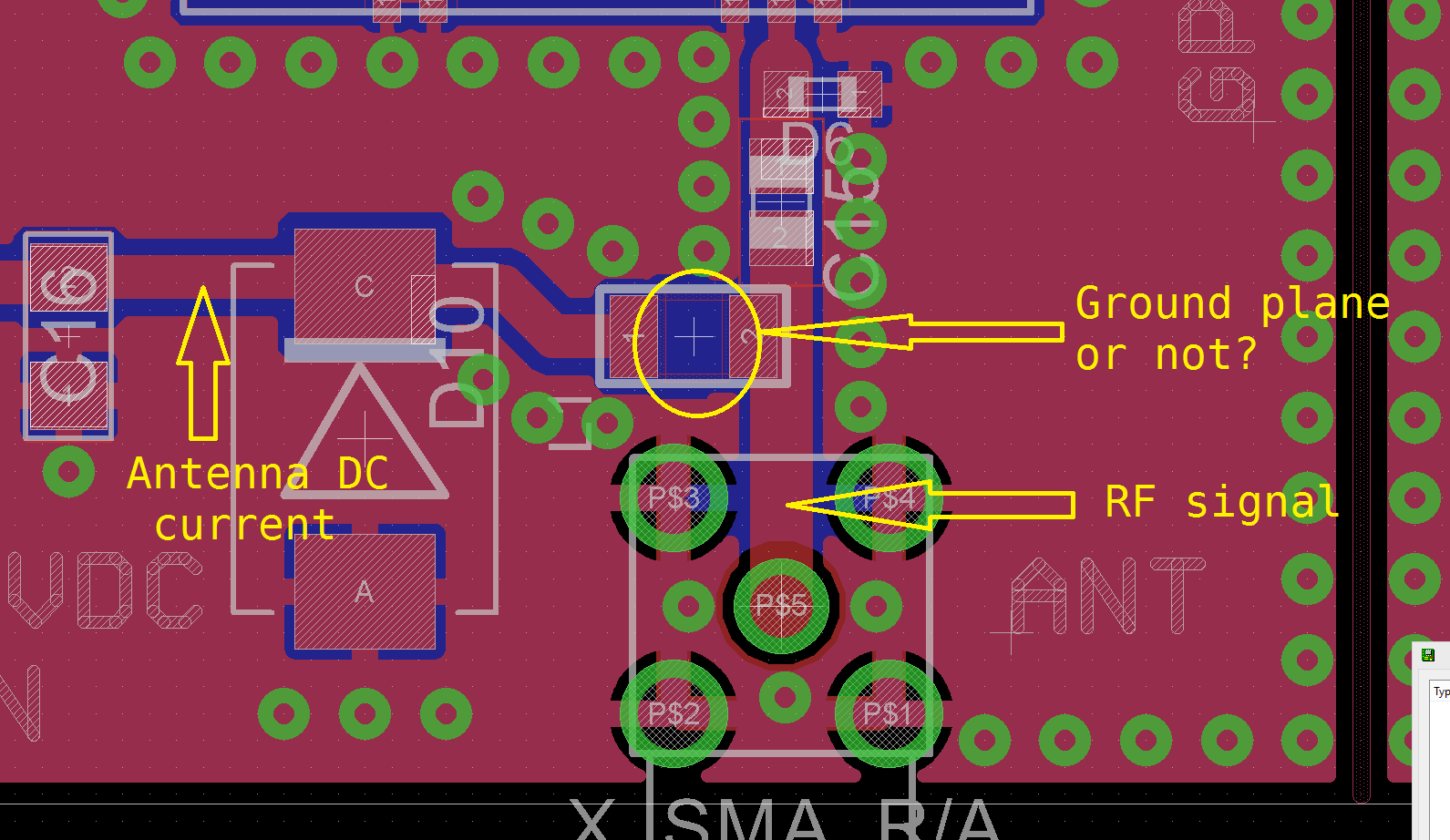Ground path under inductor?
The inductor had a restrict area underneath it in Eagle, so currently there is no ground plane under it.
Why to allow: then the ground path for antenna microstrip would be uninterrupted
Why not to allow: Some currents flowing in that ground plane could induce noise into the inductor.
If there is somebody who has good experience in RF design would really appreciate an opinion.
The frequency of RF signal is 1575 MHz

A ground place close to the inductor will load the inductor and cause a reduction in the Q. A decision must be based on the specific function of the inductor at that point in the circuit.
The purpose of the inductor is to block the RF signal and feed the antenna line with DC current (bias tee). Maybe removing ground on the bottom side of the board would also be considered?
The current through inductor in normal conditions is 100mA max. In case of external surge voltage, the inductor should pass as much current as possible through a large TVS on the left of inductor.
If Q stands for resistance then maybe it is not that important? Because it only negatively affects the DC current not RF right?
Why would you pass the decision if the ground plane should be continuous to a cad tool? You'll decide according to the datasheet and your knowledge of circuit function.
It's generally unwanted to interrupt the ground plane of a RF circuit, you'll e.g. affect the nearby micro strip. There are a few cases where you might consider power plane cut-outs, e.g. for power inductors with open magnetic path, but usually not for RF chokes.
If I understand correctly, having a load on the inductor is a desirable quality. It would dissipate the RF energy efficiently.
Thanks a lot, I will remove the restrict area.
To my experience you don't need RF ground under the inductor, its choke and ground underneath the choke will interrupt with its inductance. RF boards usually have continuous ground plan underneath the PCB that has to be continuous in order to maintain the characteristic impedance of the printed components, as long as that ground is continuous and uninterrupted than you are fine.
I hope this was helpful.
Hi thanks for reply, yes there is a ground plane underneath the antenna trace, but the ground on either side of the trace on the top layer is just to add extra capacitance to mach the impedance to 50 ohms.(I used this calculator) If I would remove the ground under the inductor also capacitance of the trace would decrease at that point and I would have an impedance mismach on either side of the inductor?
Hi, Sorry for too late reply but not been on forum for some time. However, answer to your question is that if your design is micro-strip based, which it seems like it is then top ground plane is there just to confine the emitted EM and you keep the top ground plane at least 2 times the trace width away from the RF traces so that it doesn't affect the Zo of the system. In my experience i have not seen ground plane being poured underneath the inductor because inductor's dielectric (PTFE, Air etc) will decide its inductance characteristics not the ground plane underneath however if you do pour ground plane underneath the inductor then the 180Deg out off phase RF flowing in the ground plane will affect its inductance and you might not get the same results as expected from this inductor.
you can download a much simpler Zo calculator from following link its called TxLine
http://www.awrcorp.com/products/opti...ine-calculator
I hope this answers your question, sorry again for the late reply.
you do not mention if the back side is a continuous ground plane or not...that makes a big difference.
Ground immediately under the inductor can add capacitance that might make it resonate in your frequency--i.e. a bad thing
I see some confusion in the microstrip impedance considerations. If you have a series inductor in a transmission line, the impedance can't be same (e.g. 50 ohms) on both of it's sides. To discuss impedance matching and transmission line design seriously, we need a schematic with component values and designed impedances.
Ground plane cut-outs are suggested for some power inductors with open or semi-open magnetic path. It's unusual for RF inductors. Although they often have an open magnetic path, placement of a ground plane is rather normal. The plane will displace the magnetic field on one side of the inductor and cause a certain inductance reduction but but not affect the inductor Q much.
